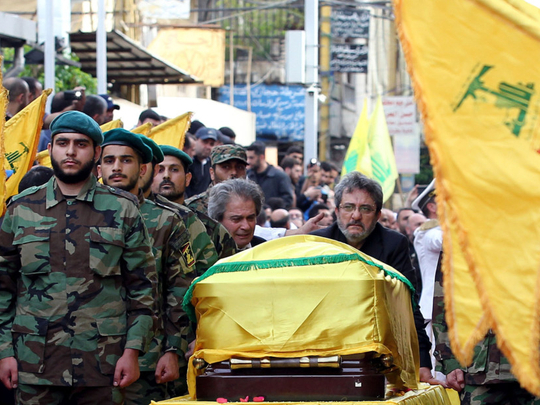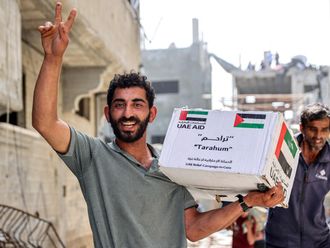
Beirut: A rebel onslaught on the town of Khan Tuman near Aleppo last week delivered one of the biggest battlefield setbacks yet to the coalition of foreign Shiite fighters waging war on behalf of Syrian President Bashar Al Assad.
Reports put the death toll among the Iranian, Afghan and Lebanese militiamen as high as 80 in the attack spearheaded by the Al Qaida-linked Al Nusra Front. At least 17 of the dead were Iranians, seemingly the highest toll in a battle outside the Islamic Republic’s borders since the Iran-Iraq war.
“Pray for us, we can’t move. There are 83 of us in one room. We’re waiting for artillery backup so we can pull back,” an Iranian fighter wrote in a WhatsApp message, quoted by state-run Iranian website Jaam-e-Jam.
“God willing, we are martyred rather than taken prisoner.”
Events in Khan Tuman were followed by an even bigger blow to Iran and its allies: news emerged early Friday of the killing of Hezbollah commander Mustafa Badr Al Deen, who had been overseeing the Lebanese group’s military operations in Syria.
It is unclear how such reversals will affect the course of a war that grew out of Arab Spring-inspired protests in 2011 calling for democratic change. Before Iran, Hezbollah and Russia came to Al Assad’s aid, his grip on power appeared to be failing.
The commitment of these allies to support him is seen by diplomats and Middle East experts as key to Al Assad’s survival.
Such blows are evidence of the price being paid by Iran and Hezbollah in Syria, and the wide range of adversaries they face in a multi-sided war that has escalated again in recent weeks as UN-led diplomacy has foundered.
Hezbollah, a Shiite group established by Iran’s Revolutionary Guard, said Badr Al Deen had been killed in an explosion near Damascus airport. In a statement, Hezbollah blamed it on “artillery bombardment carried out by takfiri groups in the area”.
Hezbollah uses Takfiri, an Arabic word, to describe extremist terrorist groups, which could be a reference to either Al Nusra Front or Daesh.
Hezbollah didn’t specify which group killed him.
Syrian rebels are celebrating what they see as Iran’s defeat in Khan Tuman, which followed the loss of the nearby town of Al Eis.
One security expert close to Damascus described low morale on the government side because hard-won territory had been lost.
One explanation of the reversal could be that there is less Russian air support. Russia has been mounting air strikes in support of Al Assad for seven months, but it has also been involved in US-backed diplomatic efforts and supported ceasefires.
The Syrian Observatory for Human Rights and a rebel fighting in the area said the intensity of recent Russian air strikes had diminished. That could be a source of friction between the alliance supporting Al Assad, analysts of the conflict say.
The attack by Al Nusra and its allies on Khan Tuman created shockwaves in Iran. Sites linked to the Iranian Revolutionary Guard Corps published the names and photos of 13 Iranians killed in Khan Tuman. Most of them were from a unit of the Guard in Mazandaran province in northern Iran.
But there were concerns among some Iranian officials and military leaders that the report of heavy casualties could sway public opinion against Iran’s involvement in Syria.
A press release from the Revolutionary Guard office in Mazandaran, the province where most of the Iranians killed were based, reflected these concerns.
In order to “preserve calm in society” only information released by their office should be trusted, it said.
Among the Iranians killed was Shafie Shafiee, a commander of the elite Quds force, according to the Tasnim news site, which is affiliated to the Revolutionary Guards. His body was seized by Syrian rebels, according to another site, ABNA.
Pictures posted by rebels and reprinted by Iranian news sites show close-ups of individual fighters killed in the battle.
One photo shows what appears to be at least a dozen bloodied corpses lined up in the hallway of a building.
Another set of photos posted by the Syrian opposition show two prisoners of indeterminate nationality, bound and bloodied, being led behind a vehicle.
Mohammad Saleh Jokar, a member of the Iranian parliament’s National Security and Foreign Policy committee, said there were not any precise numbers on how many Iranians had been killed or taken prisoner in the Khan Tuman “disaster”.
Parliament speaker Ali Larijani called it a crime carried out by “cowardly terrorists” during a ceasefire — an apparent reference to a cessation of hostilities agreement to which Al Nusra Front and Daesh are not a party.
“This incident will not go unanswered,” Ali Shamkhani, secretary of the Supreme National Security Council, said in an interview with the Young Journalists Club news site last week.
Footage shot from a drone by rebels shows a complex assault on Khan Tuman that began with a barrage of rockets or mortars and involved armoured vehicles and a tank. A mushroom cloud, apparently caused by a car bomb, is seen erupting near a building.
Iran has announced the death of half a dozen generals in Syria, and a much larger number of less senior officers since 2012.
Hezbollah has meanwhile lost four prominent fighters, including Badr Al Deen, a brother-in-law of the group’s late military commander Emad Moughniyah.
Badr Al Deen was the most senior Hezbollah figure to be killed since Moughniyah was assassinated in 2008, also in Damascus.
Hezbollah is estimated to have lost a total of around 1,200 fighters in Syria, where its highly trained guerrillas have provided crucial support to the Syrian military.











